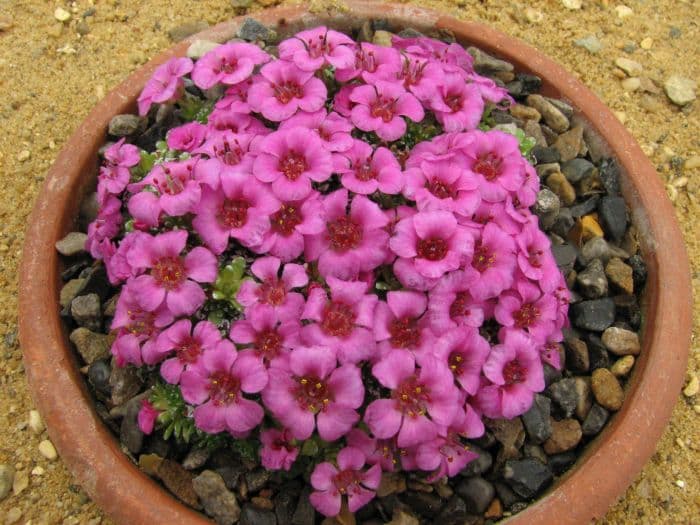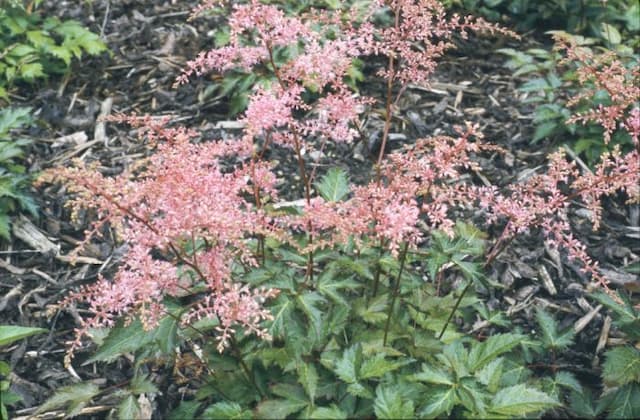Mossy Saxifrage Saxifraga 'Paul Rubens' (7)

ABOUT
Saxifraga 'Paul Rubens' is a charming perennial plant known for its ornamental appeal. This evergreen variety sports a lush cushion of mossy, rosette-forming foliage. The leaves are small, rounded, and often have a textured surface, giving them a somewhat frosted appearance. They are typically a bright green color that can add a vibrant touch to any garden setting. Adding to its beauty, Saxifraga 'Paul Rubens' produces delightful sprays of flowers. The blooms are petite and star-shaped, arranged in loose clusters atop slender, reddish stems that rise above the foliage. These flowers commonly exhibit a delicate pink hue, which may vary in intensity, sometimes accented with deeper pink veining. The charming contrast between the greenery and the pink blossoms makes this plant an attractive choice for rock gardens and alpine displays. During the blooming season, Saxifraga 'Paul Rubens' becomes particularly eye-catching as the flowers create a soft, cloud-like effect over the mounding foliage. The plant overall is well-suited for borders, edging, or as groundcover, where it can spread its quaint charm without overwhelming the space. Its appearance can add dimension and a touch of whimsy to garden compositions, especially when planted in groups for a more dramatic effect.
About this plant
 Names
NamesFamily
Saxifragaceae.
Synonyms
Paul Rubens Saxifrage, Mossy Saxifrage, Purple Robe Saxifrage.
Common names
Saxifraga 'Paul Rubens'.
 Toxicity
ToxicityTo humans
The plant commonly known as mossy saxifrage is not known to be toxic to humans. There are no significant reports of poisoning or adverse effects from ingesting or coming into contact with the mossy saxifrage. Therefore, ingestion of this plant is not typically associated with symptoms of poisoning.
To pets
Mossy saxifrage is not known to be toxic to pets either. It is not listed as a plant that commonly causes poisoning in animals, such as cats and dogs. Consequently, ingestion of mossy saxifrage is not expected to cause any significant symptoms of poisoning in pets. However, as with any non-food item, ingestion in large amounts may potentially cause gastrointestinal upset or blockages.
 Characteristics
CharacteristicsLife cycle
Perennials
Foliage type
Evergreen
Color of leaves
Green
Flower color
Pink
Height
0.5 feet (15 cm)
Spread
1 feet (30 cm)
Plant type
Herb
Hardiness zones
3
Native area
Europe
Benefits
 General Benefits
General Benefits- Easy to Grow: Saxifraga 'Paul Rubens' is known for being low maintenance and easy to cultivate, making it a good choice for beginner gardeners.
- Ornamental Appeal: This plant adds visual interest to gardens with its delicate pink flowers and attractive, mounded foliage.
- Rock Garden Fit: Perfectly suited for rock gardens, it thrives in the nooks and crannies of rocky landscapes.
- Drought Tolerance: Once established, it has good drought resistance, requiring minimal watering in the right conditions.
- Seasonal Interest: It provides seasonal blooms typically in the spring or early summer, enlivening the garden during this time.
- Ground Cover: Saxifraga 'Paul Rubens' can serve as an effective ground cover, filling in spaces and suppressing weeds.
- Attracts Pollinators: Its flowers are known to attract bees and other pollinators, aiding in the health of the garden ecosystem.
 Medical Properties
Medical PropertiesThis plant is not used for medical purposes.
 Air-purifying Qualities
Air-purifying QualitiesThis plant is not specifically known for air purifying qualities.
 Other Uses
Other Uses- Saxifraga 'Paul Rubens' can be used in fairy gardens due to its small size and enchanting appearance, providing a whimsical touch to miniature landscapes.
- The plant can be utilized in educational settings, like schools or workshops, to teach about alpine plant adaptations and rock gardening techniques.
- These flowers can serve as a subject for botanical art, inspiring artists with their delicate form and vibrant colors for drawings, paintings, and photography.
- With its attractive foliage and flowers, Saxifraga 'Paul Rubens' can be used in corsages or as living jewelry, adding a natural element to special occasions.
- The plant's ability to grow in shallow soil makes it an excellent choice for green roofing projects, providing insulation and beautifying the roofscape.
- Could be used in culinary presentations as an edible garnish, although not commonly eaten, the flowers may add visual appeal to dishes.
- In containers, Saxifraga 'Paul Rubens' can be used as a 'spiller' plant, adding dimension and contrasting texture to mixed plant arrangements.
- During the holiday season, Saxifraga 'Paul Rubens' can be incorporated into wreaths or table centerpieces for a touch of natural beauty.
- This plant can be placed in terrariums to create miniature echo systems where its compact growth habit and tolerance for moisture are beneficial.
- As a ground cover in shaded rock gardens, Saxifraga 'Paul Rubens' helps to suppress weeds while providing a lush carpet of foliage and blooms.
Interesting Facts
 Feng Shui
Feng ShuiThe Strawberry Begonia is not used in Feng Shui practice.
 Zodiac Sign Compitability
Zodiac Sign CompitabilityThe Strawberry Begonia is not used in astrology practice.
 Plant Symbolism
Plant Symbolism- Endurance and Tenacity: The Saxifraga, commonly known as the Rockfoil, often grows in rocky areas, symbolizing the ability to thrive in challenging conditions and endure hardships.
- Determination: Rockfoil's growth habit, breaking through tough surfaces, stands for strong willpower and the determination to overcome obstacles.
- Protection: Due to its sturdy nature, Rockfoil can also symbolize safety and protection against adversities.
- Persistence: The Rockfoil's ability to persist in less than ideal environments represents persistence in the face of difficulty or long-lasting ventures.
 Water
WaterMossy Saxifrage, which is the common name for Saxifraga 'Paul Rubens', prefers consistently moist soil but does not like to be overwatered. It's important to allow the top inch of soil to dry out slightly before watering again. Depending on the environmental conditions, this might mean watering approximately every week with around 8-16 ounces of water. During hot, dry periods, you might need to water it more frequently, while in cooler or more humid conditions, it may require less frequent watering. Always check the soil moisture level before adding water to prevent root rot.
 Light
LightMossy Saxifrage thrives in partial shade to full sun, making it versatile in terms of lighting conditions. It does best when it's protected from the harsh afternoon sun, so a spot that receives morning light and dappled afternoon shade is ideal. Ensure the plant receives a few hours of sunlight per day to maintain its health and vibrant foliage.
 Temperature
TemperatureThe Mossy Saxifrage is hardy and can withstand a range of temperatures but thrives in cooler conditions. Ideally, it should be kept in an environment where the temperature ranges from 60 to 75 degrees Fahrenheit. It can survive brief periods of cold down to about 10 degrees Fahrenheit but should be protected from prolonged freezing temperatures to prevent damage.
 Pruning
PruningPrune Mossy Saxifrage to remove dead or yellowing leaves and encourage a compact growth habit. This can be done in early spring or after the plant has finished flowering. It's typically not necessary to prune more than once a year unless you are shaping the plant or controlling its spread in a garden setting. The best time for pruning is just after blooming to allow time for new growth before the colder months.
 Cleaning
CleaningAs needed
 Soil
SoilThe best soil mix for Mossy Saxifrage, which is the common name for Saxifraga 'Paul Rubens', should be well-draining with added grit or sharp sand. A blend of loamy soil, peat, and perlite or vermiculite can create the right environment. The preferred soil pH level for this plant is slightly acidic to neutral, ranging from 5.5 to 7.0.
 Repotting
RepottingMossy Saxifrage should be repotted every 2 to 3 years to refresh the soil and accommodate the growth of the plant. It's important not to over-pot, so choose a container only slightly larger than the previous one.
 Humidity & Misting
Humidity & MistingMossy Saxifrage thrives in moderate humidity levels. While it can tolerate a range of humidity conditions, it prefers a level that is consistent with what is typically found in a household environment. Excessive humidity should be avoided to prevent rot.
 Suitable locations
Suitable locationsIndoor
Place in bright, indirect light; water when top soil is dry.
Outdoor
Grow in partial shade, shelter from intense sun, and protect from harsh winds.
Hardiness zone
3-8 USDA
 Life cycle
Life cycleThe Strawberry Begonia, despite its name, is not a true begonia but a saxifrage species. The life cycle begins with seed germination, which requires a moist, well-draining environment, typically in spring. Following germination, the seedlings grow into a rosette form with intricately patterned leaves. The plant then enters a vegetative stage, where it develops runners (stolons) that spread out and may form new plantlets at their tips, allowing the plant to propagate asexually. During its blooming period, usually in late spring to early summer, the Strawberry Begonia produces clusters of attractive pink or white flowers on tall, slender stalks. After flowering, seeds are produced and dispersed, completing the cycle if they find suitable conditions for germination.
 Propogation
PropogationPropogation time
Spring-Early Summer
Propogation: Saxifraga 'Paul Rubens', commonly known as Mossy Saxifrage, can be propagated through division, which is the most popular method used for this plant. The best time to divide Mossy Saxifrage is in the early spring or just after the plant has flowered. To propagate by division, carefully dig up the plant and gently separate the clumps into smaller segments, ensuring that each segment has a portion of the roots intact. It is critical to replant the divisions quickly to prevent the roots from drying out. It is recommended to plant the divisions at the same depth they were growing previously and to water them well. This method is straightforward and helps to rejuvenate older clumps that might be woody or nonproductive at their center, encouraging healthier growth and maintaining the vigor of the plant.








![Alum root [Ebony and Ivory]](/_next/image?url=https%3A%2F%2Fplants-admin.emdemapps.com%2Fimages%2Fplants%2F%2Fimages%2F604b5da86747a.png&w=640&q=75)
